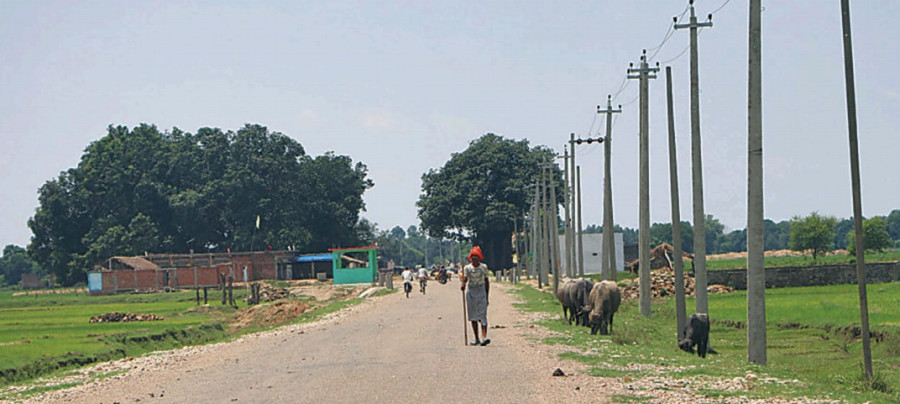National
Access to electricity is making new entrepreneurs in rural areas
As electricity reaches rural areas at affordable rates, local communities are utilising the resource for income generating activities.
Chandan Kumar Mandal
Indra Kumar Thapa spent most of his life in India where his father lived and worked. Thapa, originally from Sindhuli, completed his school education and later worked as a cook in a restaurant in Kolkata.
“I lived and worked in India for 22 years. During all those years, I felt our family was divided between India and Nepal,” said Thapa, now 40. “I used to come home during a few weeks of leave every year and head back to Kolkata once the holidays were over. But I always wanted to come home and do something here.”
It took several years for Thapa’s dream to materialise. Back then his village at Marin Rural Municipality did not have electricity, without which his plan of starting his own business was impossible.
When the village finally had electricity access nearly five years ago, Thapa returned home and decided to start a rice mill.
The rice mill has not just given Thapa business, it has also supported local farmers, who earlier had to take their rice to Tarai districts for processing.
“The wait for electricity was long. Villagers would either sell their unprocessed rice in Tarai districts and then buy rice with the money or take the rice to the mills in Sarlahi and carry the freshly processed rice back home,” said Thapa. “Ever since I started the mill, the villagers no longer have to travel outside to process their rice. This has become possible due to electricity.”
Besides powering homes, electrification of rural areas has also supported entrepreneurship and created livelihood opportunities.
Thapa says electricity access has stemmed the job migration trend in rural areas to a certain extent.
“Earlier, people would go to work in India and Gulf countries. Some people are still there but now my village also has businesses like furniture factory, bakery, grill workshop and mill,” said Thapa, who is also a member of Kalpavriksha Rural Electricity Cooperative Limited, a local group of electricity consumers.
“All this would not have been possible without electricity,” added Thapa.
According to the Economic Survey of 2019-20, 90 percent of the population has access to electricity as of February 2020, up from 88 percent in July 2018.
As per the Energy Progress Report, 2019, released by the five Sustainable Development Goal stakeholder agencies—Nepal’s access to electricity increased at an annual rate of 4.3 percent, which is much higher than the global average of 0.8 percent, making Nepal among the fastest electrifying countries in the world.
The credit for rapid electrification in the country goes to the community based rural electrification schemes which connect rural communities without access to electricity with the national grid.
“It is difficult to reach all the areas through our efforts because of our disintegrated settlements. Through rural electrification programmes, communities also take ownership and manage the project at the local level,” said Madan Timsina, a spokesperson for Nepal Electricity Authority, the state power utility.
Under a rural electrification programme, communities, who wish to be connected with the national grid, form consumers’ groups. Ninety percent of the project cost is carried by the government, whereas the local communities bear the remaining 10 percent of the cost.
Through community-based rural electrification schemes, more than 360,000 households have been electrified, according to Narayan Gyawali, chairman of National Association of Community Electricity Users-Nepal, a national federation of Community Electricity User Groups.
“These electricity users’ groups do not produce electricity themselves but manage its efficient distribution and promote its productive usage for improving livelihood,” Gyawali told the Post. “Once the electricity reaches rural areas, such communities also see the arrival of technologies along with electricity, giving them options of utilising the energy. Therefore, they start various enterprises in their community or use electricity for agriculture as well.”
There are more than 300 electricity users’ groups in 54 districts that are involved in instructing locals on effective and efficient use of energy for households and business development.
Khimti Rural Electric Cooperative Limited is one such group that has electrified nearly 9,500 households and distributes electricity to more than 50,000 people in local units of Ramechhap and Dolakha district.
According to Kumar Phuyal, general manager of the company, nearly 300 small to medium level businesses are in operation under the community users’ group.
“We had to utilise produced electricity which is not possible through daily use. So we also train locals to start their own venture where electricity, provided at subsidised rates,” said Phuyal. “Such small scale industries have been a blessing for rural areas where the job is scarce and agriculture is not profitable, which has led young people to migrate.”
Indu Karki is one of the consumers who decided to utilise the electricity in her village for income generation.
After losing her house to the earthquake of 2015, she was looking to do something to support her family in her locality—Likhu Tamakoshi Rural Municipality.
“My house was completely destroyed in the earthquake, and there was not much to do to support my family of ten,” said Karki. “I had to do something, but there was no job. After studying the local market, I found out there was no mill for grinding spices and locals had to go elsewhere.”
As electricity became readily available, she converted her diesel-run mill into an electric one and started processing spices and extracting edible oil.
“Earlier, diesel required for the generator had to be carried for several hours. Electricity has saved me all the hassle. It saves time and energy,” said Karki. “Once I knew how the available energy could be utilised for income generation, I did it accordingly. Now, I am earning more with less investment. My business runs on clean energy now. Burning diesel was not only expensive, but also hazardous.”
Encouraging the public to use electricity for their daily needs and enterprises is crucial not only for shifting the country's dependence on traditional and fossil-fuel-based energy resources to clean and renewable energy but also to consume produced electricity which is expected to increase in coming years massively.
According to the economic survey, the power generated in the first eight months of the fiscal year 2019-20 has increased by 8.3 percent to 1,355 MW compared to 1,251 MW, the total electrical power generated by the fiscal year 2018-19. Of the total generated electricity, 1,233 MW had come from hydroelectricity, 54 MW from thermal plant and 68 MW from renewable energy.
As per the survey, traditional, commercial and renewable energy consumption to total energy consumption has been 68.7 percent, 28.1 percent and 3.2 percent, respectively in the first eight months of the fiscal year 2019-20.
By the end of mid-March of the fiscal year 2019-20, about 10 percent of the total population have access to electricity from renewable energy sources while 36 percent of the population have been using clean, renewable energy for various purposes.
With the increase in energy generation, Nepalis have been consuming more electricity than a few years ago, which is projected to go up even more in coming years.
“If we do not make communities use available energy for productive use, they would either misuse it, or the generated electricity will go to waste. However, only asking them to consume electricity without supporting their income is also impractical,” said Gyawali.
“Besides household consumption, electricity should be used for income generation which has happened in rural areas,” said Gyawali. “Most of these entrepreneurs are women and from marginalised communities. At least these people should earn money to pay for the monthly electricity bill.”
According to experts, encouraging the public to use electricity instead of fossil fuels and traditional energy sources is also essential for eliminating indoor air pollution.
“While providing electricity to local communities, we also promote clean cooking services through the use of biogas, improved cooking stoves and electricity for cooking,” said Nawa Raj Dhakal, a spokesperson with Alternative Energy Promotion Centre.
“Besides, there should also be a productive use of available energy for livelihood beyond consumptive use for household needs. Many small and medium level enterprises have been operating, thanks to electricity access. The point is these communities should not pay electricity tariff from their pockets but from income made from the electricity.”
Following the footsteps of other women entrepreneurs, Mandira Bhandari of Ramechhap also expanded her cosmetic shop and started beauty parlour three months ago.
“Electricity is needed to iron, straighten, highlight and dry the hair these days,” said Bhandari, a resident of Gokulganga Rural Municipality-3. “The electricity has come like a blessing for women like us who had nothing much to do in the village. Now, they are not only busy with work but also earning money.”




 16.12°C Kathmandu
16.12°C Kathmandu















